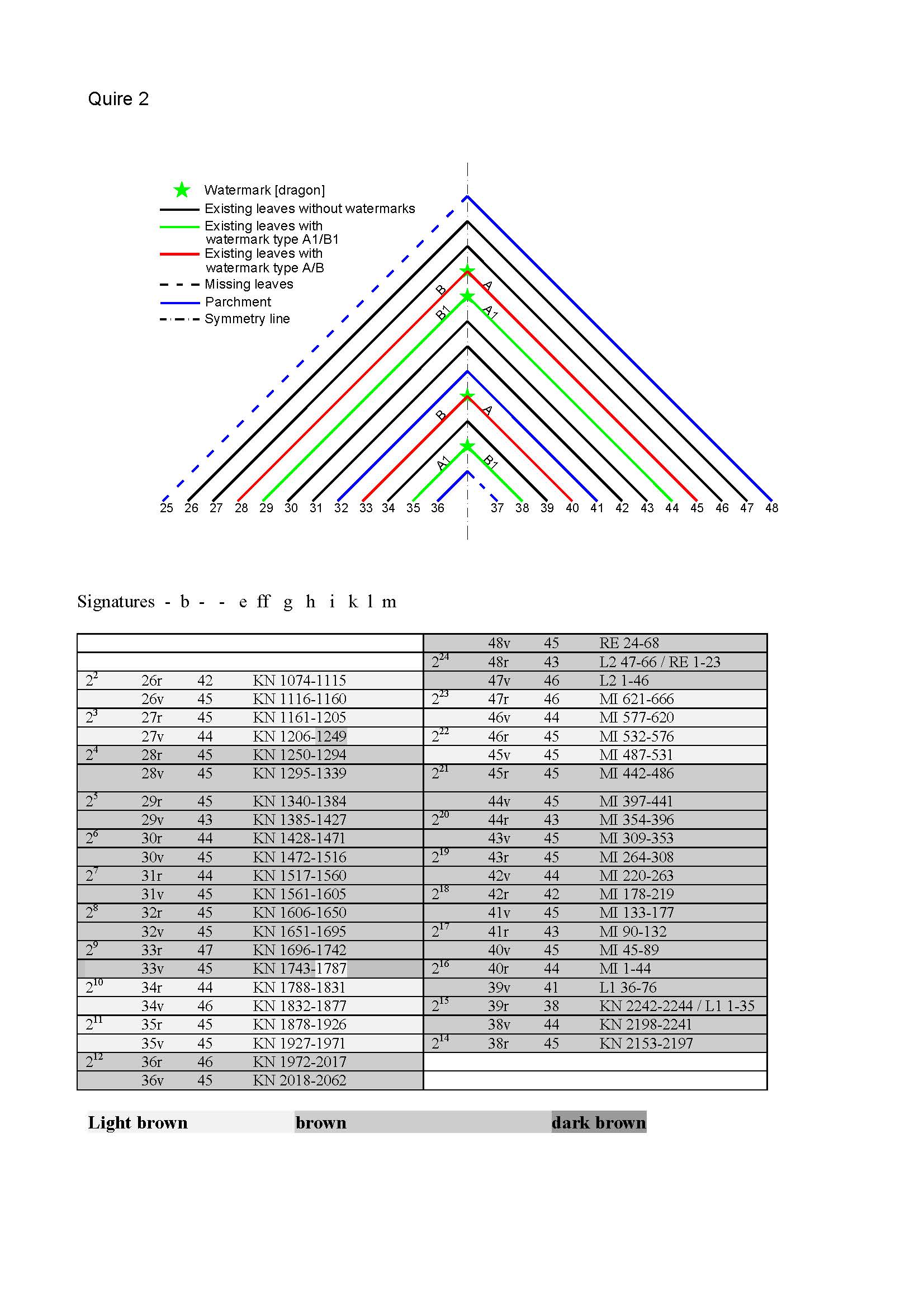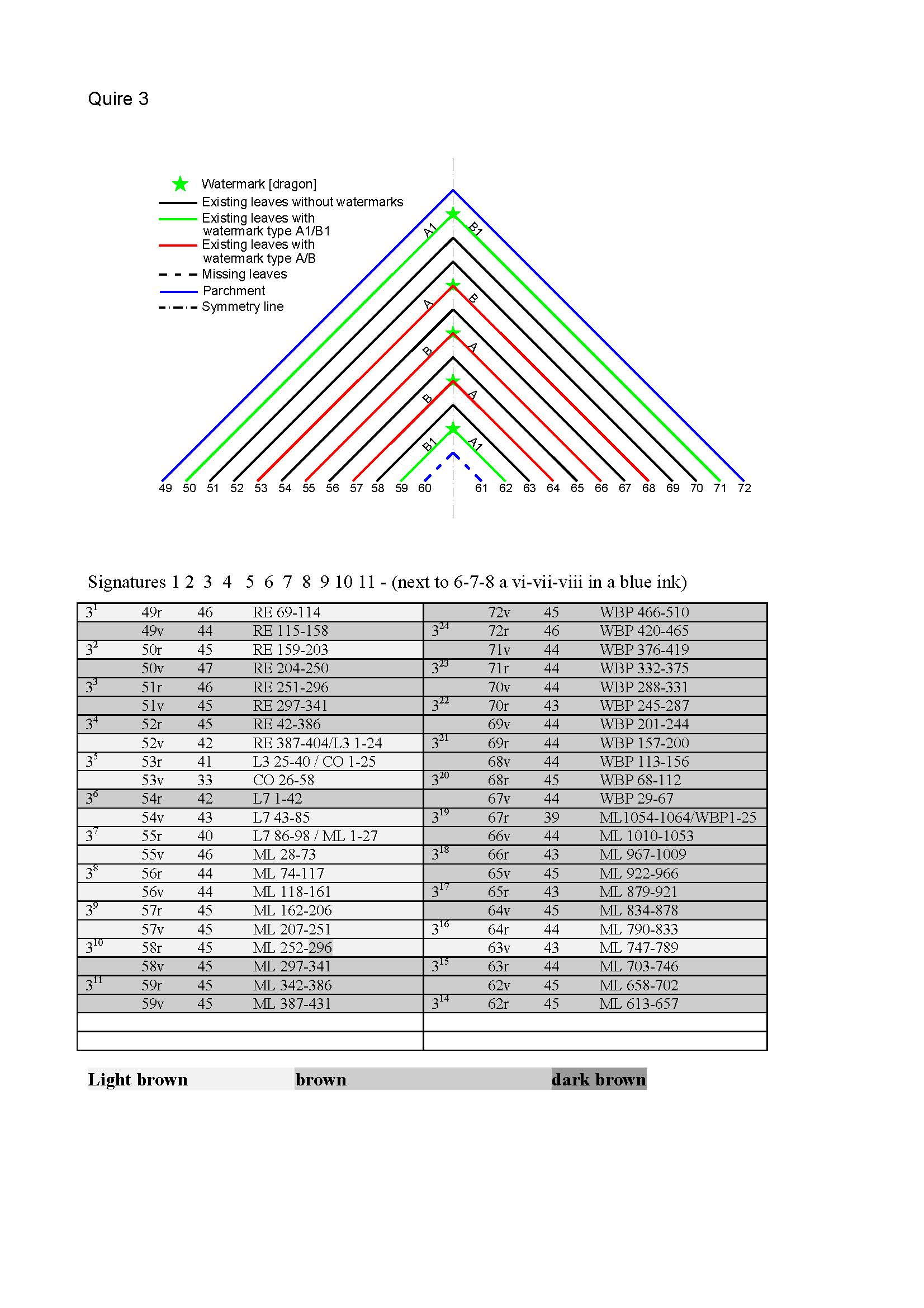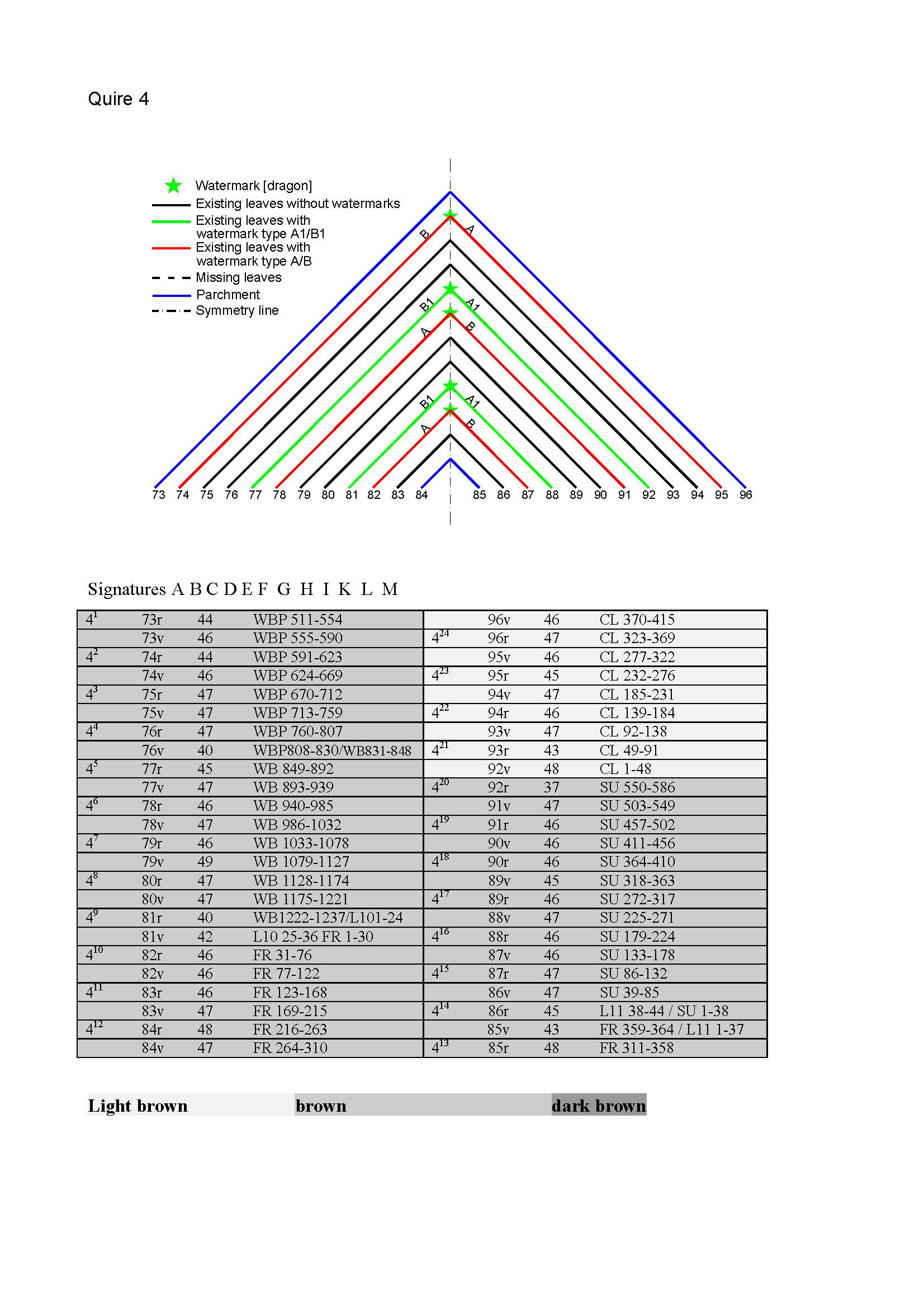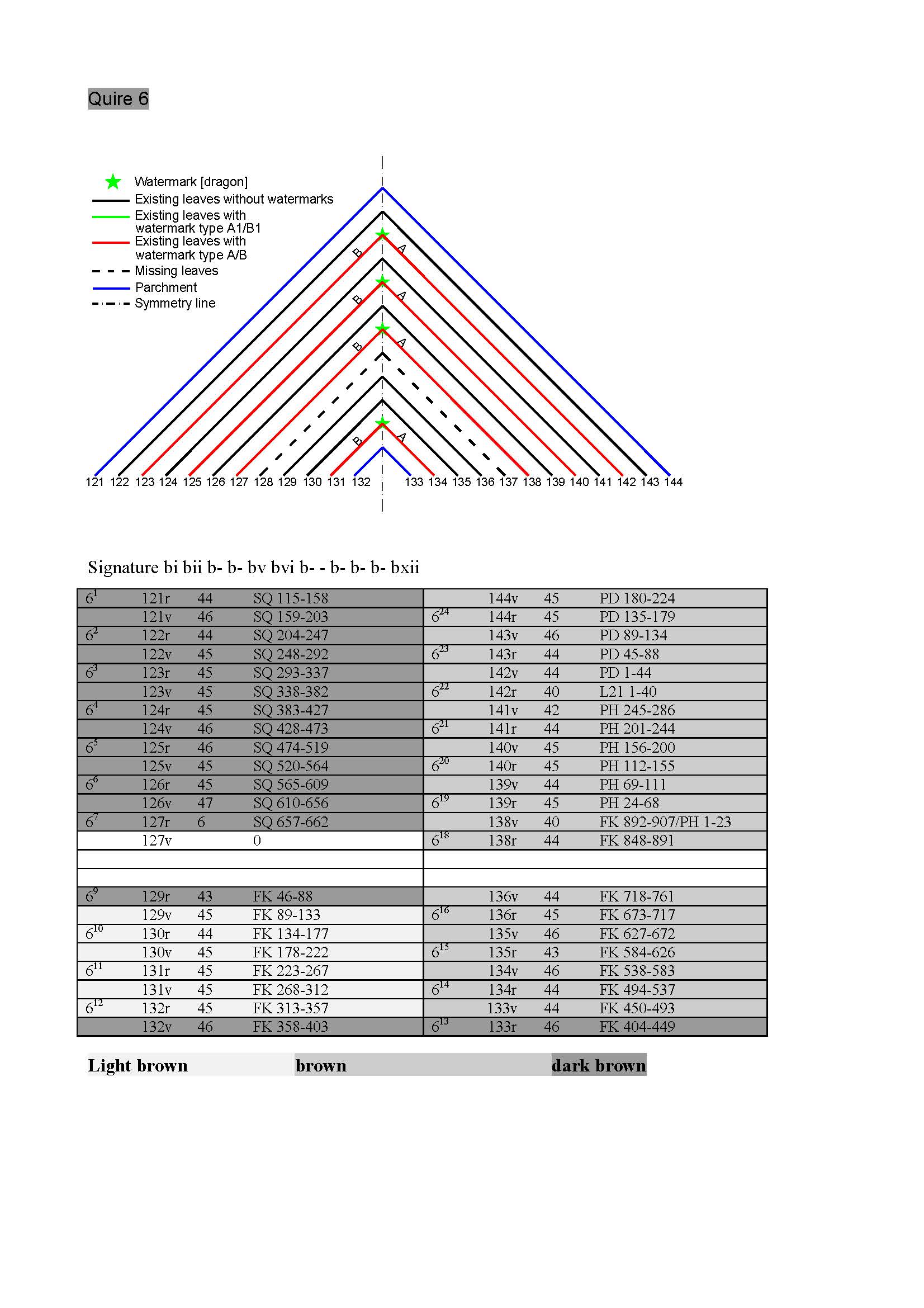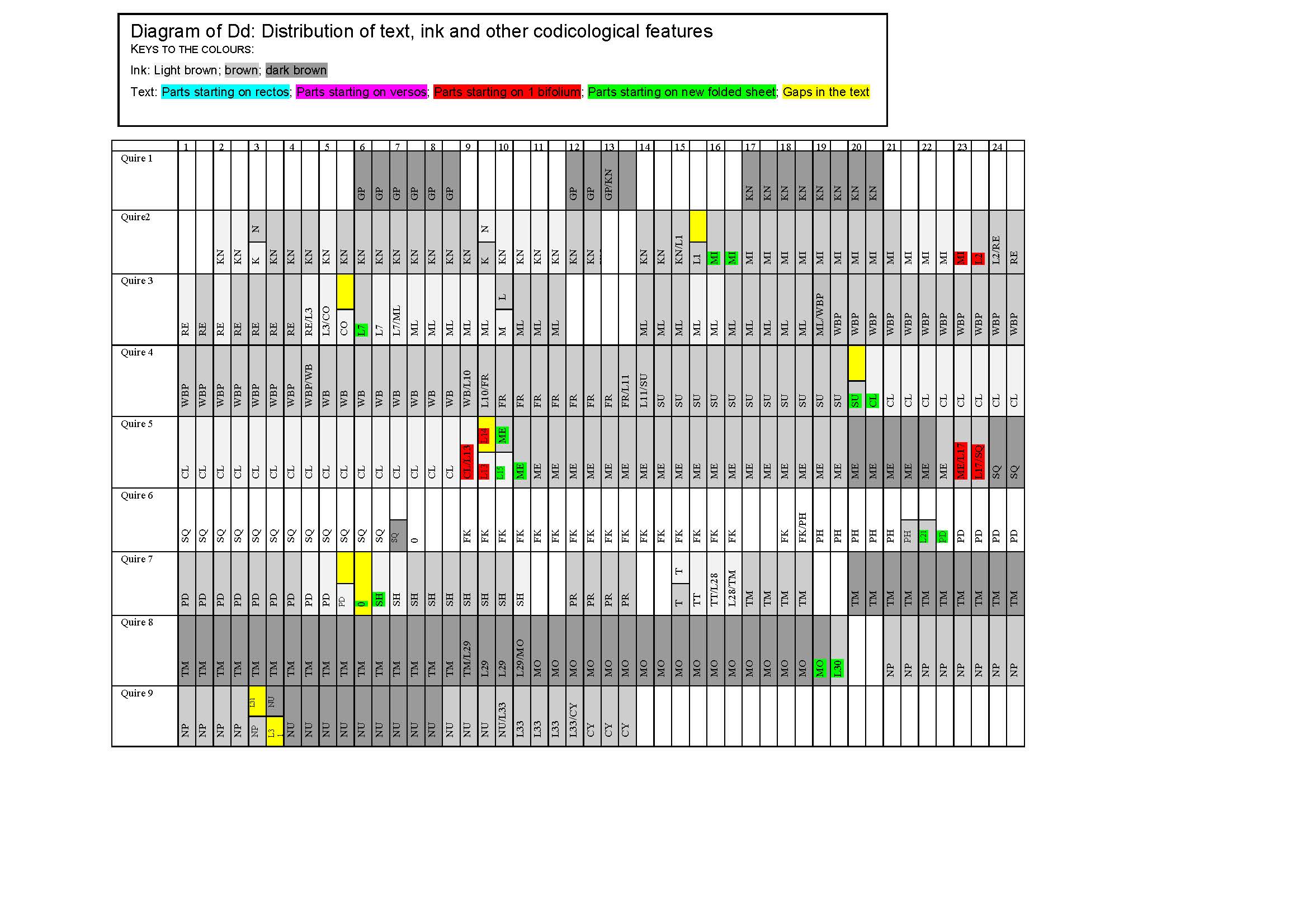7 4. Structural observations
Dd is made up by 216 folios, of which 35 are missing. The manuscript contains two foliations: a nineteenth-century foliation in Roman numerals added in pencil in the right-inside margin probably used to direct the binder during the first disbinding. The second foliation, which is in Arabic numerals, counts lost leaves and appears at the top right of each folio.
5 4.1. Quiring
Each regular quire is made up of twenty four leaves. Five sheets of paper are folded into quarto form and gathered between parchment inner and outer bifolia. Fols. 32 and 41 in quire 2 (8/17) is a leaf of vellum bent into a bifolium.
The manuscript is comprised of 9 quires: 1 (9: 1-5, 9-11, 14-16, 21-24 lost); 2 (22: 1, 13 lost); 3 (22: 12, 13 lost); 4 (24); 5 (24); 6 (22: 8, 17 lost); 7 (21: 11, 14, 19 lost); 8 (23: 20 lost); 9 (13: 14-24 lost. There is an annotation on the last folio of the ninth quire (fol. 205v). It was inserted to indicate that the rest of the quire and two more quires had gone.
Catchwords appear at the foot of the last leaf of each completed quire. The paraph marks are all red.
| Quire | Catchwords | Corresponding text in the following folio |
|---|---|---|
| 2, fol. 48v | ¢ And namelich þere was | And namelih there was |
| 3, fol. 72v | ¢ That though he had | That though he had |
| 4, fol. 96v | ¢ But eke beside | But eke beside |
| 5, fol. 120v | ¢ As doth an Egle | As doth an Egle |
| 6, fol. 144v | and thurgh thy dronke nose: | And thurgh thy dronke nose/ |
| 7, fol. 168v | manye children | manye children |
| 8, fol. 192v | But I ne kan nat | But I ne kan nat |
Signatures appear on the right outside of the lower corner on the recto of the folio and are written in brown ink in the main scribe's hand. Many leaves are damaged, therefore not all the signatures are now visible. However, a list of what can be detected follows:
| Quire | Signatures | Folios |
|---|---|---|
| 2 (2,5-12) | b,e,ff-m | fols. 26r,29r-36r |
| 3(1-11) | 1-11 | fols. 49r-59r |
| 4(1-12) | A-M | fols. 73r-84r |
| 5(1-12) | a i-xii | fols. 97r-108r |
| 6 (1-6,8-12) | bi, bii, b, b, bv, bvi, b, b, b, b, bxii | fols. 121r-127r,129r-132r |
| 7(2-9,12) | cii-cvi, cv-, cviii-cxii | fols. 146r-155r, 156 |
| 8(1-5,7-12) | d, diii, d, dv, dv-, d, d, d, d, dxii | fols. 169r-171r, 180r |
| 9(1/12) | e-exii | fols. 193r-204r |
A diagrammatic representation of each quire can be seen in the section 'Diagrammatic representation of the quires'.
7 4.2. Ruling and layout
Each folio was pricked and the writing frame ruled. Pricking is visible on each folio in four distinctive places. They appear in all four edges. The pricking on the left top and bottom edges measures 1.5 cm from the left margin and 1 cm from the bottom and top margins. The pricking of the inside edges is visible, but the binding prevents an exact calibration of the precise place. The frame was marked with dry point, brown crayon and brown ink. While dry point seems to be a constant method of ruling for the paper leaves, the folios in vellum had a different treatment. The first quire was ruled with dry point regardless of the material used for writing. In the second and third quires the parchment is ruled with brown ink. From the fourth to the fifth quire it is difficult to detect the ruling material for the parchment, probably dry point. In the ninth quire the ink is again used for the parchment.
The size of the frame, which accommodates the text, is variable. It is regular in the paper leaves, measuring 220 mm in length x 130-140 mm in width. Since the parchment folios are irregular in size, the frame varies from 210 mm in length x 110 mm in width (fol. 108) to 220 cm x 130 cm (fol. 48). The scribe tried to squeeze the text by slightly reducing and compressing the size of his handwriting so that the average 45 lines a page could be accommodated.
The layout of the text is in one single column and runs continuously, though gaps within the text appear. A list of these gaps can be seen in the 'Diagrammatic representation of Dd'. Below I include a table showing these gaps.
| Folio | Part of the text | Size |
|---|---|---|
| 39v | End of L1 | 2 cm from the footer |
| 53v | End of CO | 6.5 cm from the footer |
| 92r | End of SU | 3.5 cm before the explicit |
| 105v | before L14 | 1.5 cm |
| 105v | after L14 | 1.5 cm |
| 105v | after the CL& | 1 cm from the footer |
| 127r | after SQ | 18 cm from the footer |
| 149r | PD after L590 | One line break in the text |
| 149v | End of PD | 9 cm from the footer |
| 150r | Blank | |
| 195r | Before L31 | 1.5 cm |
| 195v | After L31 | 8 cm |
7 4.3. Textual collation
| Quire | Leaves | Folio | Content |
|---|---|---|---|
| 1 (24) | 1-5 | 1-5 missing | |
| 6-8 | 6-8 | GP 255-506 | |
| 9-11 | 9-11 missing | ||
| 12-13 | 12-13 | GP 759-858; KN1-61 | |
| 14-15 | 14-16 missing | ||
| 17-20 | 17-20 | KN 313-643 | |
| 21-24 | 21-24 missing | ||
| 2 (24) | 1 | 25 missing | |
| 2-12 | 26-36 | KN 1074-2062 | |
| 13 | 37 missing | KN 1116-1160 | |
| 14-24 | 38-48 | KN 2153-2244; L1; MI; L2 ;RE 1-68 | |
| 3 (24) | 1-11 | 49-59 | RE 69-404; L3; CO; L7; ML 1-431 |
| 12-13 | 60-61 missing | ||
| 14-24 | 62-72 | ML 613-1064; WBP 1-510 | |
| 4 (24) | 73-96 | WBP 511-830; WB; L10; FR; L11; SU; CL 1-415 | |
| 5 (24) | 97-120 | CL 416-1176; L13; L14; L15; ME; L17; SQ 1-114 | |
| 6 (24) | 1-7 | 121-127 | SQ 115-662 |
| 8 | 128 missing | ||
| 9-16 | 129-136 | FK 46-761 | |
| 17 | 137 missing | ||
| 18-24 | 138-144 | FK 848-907; PH; L21; PD 1-224 | |
| 7 (24) | 1-10 | 145-154 | PD 225-640; SH 1-393 |
| 11 | 155 missing | ||
| 12-13 | 156-157 | PR 22-198 | |
| 14 | 158 missing | ||
| 15-18 | 159-162 | TT 34-206; L28; TM 1-90 | |
| 19 | 163 missing | ||
| 20-24 | 164-168 | TM 133-404 | |
| 8 (24) | 1-19 | 169-187 | TM 405-818; L29; MO; L30 1-23 |
| 20 | 188 missing | ||
| 21-24 | 189-192 | NP 70-419 | |
| 9 (24) | 1-13 | 193-205 | NP 420-626; L31; NU; L33; CY 1-136 |
| 14-24 | 205-216 missing |
8 4.4. The watermark sequence
The quarto format produces four distinct patterns of watermark distribution. These patterns depend on the manner of folding the sheet. It could be folded either on the felt side or on the mould side, and the paper could be either upright or upside down. In this type of format each sheet should produce two watermarked and two unmarked leaves, whatever the pattern. However, there may be instances in a quire where this symmetry is not found (Spector 1978 and 1986, pp. 7-250).
I have analysed the watermark sequence of each quire. The diagrams indicate that the quarto format is regular in the majority of the quires. However, in quires 2, 5, 6 and 7 there are insufficient examples of watermarked leaves for the paper found in those quires, and three instances of watermarked leaves that do not have unmarked halves. In quires 6 and 7 the disruption in the sequence is due to missing leaves. However, in quires 2 and 5 the scribe did not form the whole of them by dividing whole sheets into quarto format, but by folding half sheets into bifolia, and in this case the symmetry of the quire changes. In addition, in quire 2 a parchment bifolium (fols. 32 / 41) was inserted as the eighth folio in the quire. As previously noted, parchment was usually used only for the inner and outer bifolia.
The disruptions in the sequence in these four quires are as follows, the bifolia in question being unmatched: quire 2: fols. 26/47, fols. 31/42, fols. 33/40 (watermarked); quire 5: fols. 98/119 (watermarked), fols.105/112; quire 6: fols. 129/136 and quire 7: fols. 154/159 (watermarked).
In the case of quire 2, it is possible that fol. 35 and its conjugate fol. 38 could be identified as the half sheet without a matching half. Considering the mould and the felt side of the watermarked leaves, it is obvious that the independent halves are fol. 33 and fol. 40. The recto of fol. 33 is a mould side, fol. 34 recto is again a mould side. If the half had come from a folding into quarto, this pattern would not have been possible. When the mould side is outside and appears on the recto, the following folio on the recto must have the felt side.
The reasons for these irregularities may have arisen through the replacement of folios in quires that were already arranged. However, the correctness of such an analysis depends on the technique used by the scribe in preparing the quires. Thus he could have worked either with quires already prepared or with sheets purchased by the ream. The large stock of the dragon paper appearing in 8 quires seems to indicate that the scribe had that paper available in large quantities, rather than in already assembled quires or loose sheets. Lyall notes that loose sheets were used by Shirley in London, British Library MS Add. 16165 (Lyall 1989, pp. 16-7). Had the scribe of Dd done so, we would expect more types of watermarks and paper stocks. The use of loose sheets in medieval paper manuscripts is not an unusual practice (Christianson 1987, p. 30 and Da Rold 2007b).
Given the fact that in a mill there are two moulds working at one time, each ream is made up of a watermark and its twin. The purchase of a quaterna or two (Pirani 2000, p. 62), for example, would provide a scribe with paper from one paper-stock that would contain regular quires alternating a watermark and its twin. In the diagram of the quires, it can be observed that the alternation between the dragon mark (A/B) and its twin (A1/B1) in the first 8 quires is almost regular. As there is only one paper-stock used throughout eight quires, it seems reasonable to believe that the scribe had a large amount of loose paper from the same paper-stock at his disposal. This indicates that the scribe was working with loose sheets in a ream, and the folding of the paper in this format would be his duty as much as the organisation of the quire. If the scribe was preparing his quires and commonly respected the alternation between watermarked and unmarked bifolia, any disruption to this pattern would be meaningful, as any quires with watermarked or unmarked bifolia with no matching half within a quarto format would be particularly unusual.
8 4.5. Diagrammatic representation of the quires
This section contains nine figures which represent the distribution of the watermarked paper, the text and the colour of the ink in each quire. The text and the colour of the ink are organised in tables. Each table shows the congeners of every folio r/v, the folio-number, the number of lines per page, the part of the text and the lines that each folio contains. Blank folios are indicated with a white cell and an 0 - 0 stands for no text; missing folios are marked with only a white cell. Signatures are indicated when they are still extant; partial or non-existing signatures are indicated with -. In the first quire no signatures are visible.
Quire 1
Quire 2
Quire 3
Quire 4
Quire 5
Quire 6
Quire 7
Quire 8
Quire 9
9 4.6. Diagrammatic representation of Dd
This section offers an overview of the 9 quires of Dd. It represents the colour of the inks and the textual parts in each folio r/v. It also indicates the places in which there are gaps in the text and highlights those parts that start at the beginning of rectos or versos without leaving any space for the explicit and incipit. Two colours, red and green, code those parts which are copied on a single bifolium or on a sheet folded into quarto.

